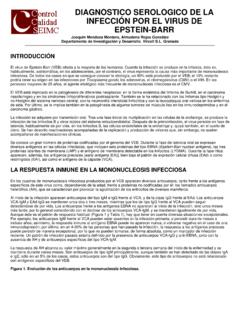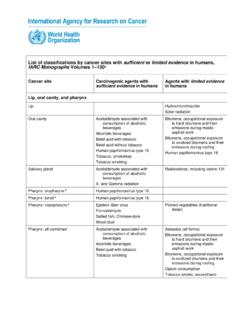Transcription of Annex 3 - World Health Organization
1 Annex 3. Recommendations for the evaluation of animal cell cultures as substrates for the manufacture of biological medicinal products and for the characterization of cell banks Replacement of Annex 1 of WHO Technical Report Series, No. 878. Abbreviations 81. 1. Introduction 84. 2. Historical overview 84. 3. Scope 88. 4. Definitions 89. 5. General considerations 95. Types of animal cell substrates 95. Potential risks and risk mitigation associated with biologicals produced in animal cell cultures 100. Part A. General recommendations applicable to all types of cell culture production 107. Good manufacturing practices 107. Principles of good cell culture practice 107.
2 Selection of source materials 112. Certification of cell banks by the manufacturer 118. Cryopreservation and cell banking 120. Part B. Recommendations for the characterization of cell banks of animal cell substrates 123. General considerations 123. Identity 126. Stability 128. Sterility 130. Viability 130. Growth characteristics 130. Homogeneity 131. Tumorigenicity 131. Oncogenicity 139. Cytogenetics 141. Microbial agents 142. Summary of tests for the evaluation and characterization of animal cell substrates 165. 79. WHO Expert Committee on Biological Standardization Sixty-first report Authors 166. Acknowledgements 168. References 168. Appendix 1. Tests for bovine viruses in serum used to produce cell banks 176.
3 Appendix 2. Tumorigenicity protocol using athymic nude mice to assess mammalian cells 180. Appendix 3. Oncogenicity protocol for the evaluation of cellular DNA and cell lysates 184. Recommendations published by WHO are intended to be scientific and advisory. Each of the following sections constitutes guidance for national regulatory authorities (NRAs) and for manufacturers of biological products. If an NRA so desires, these recommendations may be adopted as definitive national requirements, or modifications may be justified and made by the NRA. It is recommended that modifications to these recommendations be made only on condition that the modifications ensure that the biological product is at least as safe and efficacious as that prepared in accordance with the recommendations set out below.
4 The parts of each section printed in small type are comments for additional guidance, intended for manufacturers and NRAs, which may benefit from these details. WHO Technical Report Series No. 978, 2013. 80. Annex 3. Abbreviations ALS antilymphocyte serum ATCC American Type Culture Collection ATG antithymocyte globulin ATS antithymocyte serum BAV5 bovine adenovirus 5. BCG bacille Calmette Gu rin vaccine bp base pairs BPIV3 bovine parainfluenza type 3 virus BPV bovine parvovirus BRSV bovine respiratory syncytial virus BSE bovine spongiform encephalopathy BTV bluetongue virus BVDV bovine viral diarrhoea virus CCL continuous cell line CEF chick embryo fibroblasts CHO Chinese hamster ovary CJD Creutzfeldt Jakob disease CPE cytopathic effect CTL cytotoxic T-lymphocyte CWD chronic wasting disease DCL diploid cell line EBV epstein Barr virus ECB extended cell bank EFSA European Food Safety Authority ELISA enzyme-linked immunosorbent assay EMA European Medicines Agency EOP end of production EOPC end-of-production cell 81.
5 WHO Expert Committee on Biological Standardization Sixty-first report EPIC-PCR exon-primed intron crossing PCR. FBS fetal bovine serum FDA Food and Drug Administration (USA). FFI fatal familial insomnia GBR geographical BSE-risk level GMP good manufacturing practices GSS Gerstmann Str ussler Scheinker syndrome HCP hamster cheek pouch HDC human diploid cell HEK human embryonic kidney HIV human immunodeficiency virus HLA human leukocyte antigen IBR infectious bovine rhinotracheitis virus ICH International Conference on Harmonisation of Technical Requirements for Registration of Pharmaceuticals for Human Use IFA immunofluorescence assays IFN interferon LCMV lymphocytic choriomeningitis virus MAbs monoclonal antibodies MCB master cell bank WHO Technical Report Series No.
6 978, 2013. MDCK Madin Darby canine kidney mRNA messenger RNA. miRNA microRNA. MPS massively parallel sequencing NAT nucleic acid amplification technique NCL national control laboratory NK natural killer (cell). NOD non-obese diabetic NRA national regulatory authority 82. Annex 3. OIE World Organisation for Animal Health PBS phosphate-buffered saline PCC primary cell culture PCR polymerase chain reaction PDL population doubling level PERT product-enhanced reverse transcriptase PMCA protein misfolding cyclic amplification PrP prion protein RCB reference cell bank rcDNA residual cellular DNA. rDNA recombinant DNA. REO3 reovirus 3. RFLP restriction fragment length polymorphism RT reverse transcriptase SCID severe combined immunodeficiency SCL stem cell line SPF specific-pathogen-free STR short tandem repeats SV simian virus TCID50 median tissue culture infective dose TEM transmission electron microscopy TPD50 tumour-producing dose at the 50% end-point TSE transmissible spongiform encephalopathy vCJD variant CJD.
7 VNTR variable number of tandem repeats VSV vesicular stomatitis virus WCB working cell bank 83. WHO Expert Committee on Biological Standardization Sixty-first report 1. Introduction Cell substrates are cells used to manufacture biological products. It is well established that both cell substrates themselves and events linked to cell growth can affect the characteristics and safety of the resultant biological products. Therefore, a thorough understanding of the characteristics of the cell substrate is essential in order to identify points of concern and to develop a quality control system that addresses these points. Recent advances in the use and quality control of new animal cell substrates particularly continuous cell lines (CCLs) and insect cells led to the conclusion that an update to the WHO requirements (Requirements for the use of animal cells as in vitro substrates for the production of biologicals) (1) should be prepared.
8 In order to facilitate the resolution of regulatory/scientific issues related to the use of animal (including human) cell cultures as substrates for the production of biological products, WHO initiated this revision of its requirements on cell substrates by establishing a WHO Study Group on Cell Substrates. Animal cells refer to cells derived from organisms classified as within the animal kingdom. This document is the result of the Study Group's work, which included a wide range of consultations with individuals and organizations with expertise in this area. After comments were received from this consultative process, and from invited reviewers, further revision of the draft recommendations was undertaken and presented to the WHO Expert Committee on Biological Standardization in 2010.
9 During the development of this document, guidance on the topic issued by other relevant organizations was considered. An effort was made to make the recommendations compatible with existing guidance whenever possible. These Recommendations provide guidance to national regulatory authorities (NRAs), national control laboratories (NCLs) and manufacturers on basic principles and, in some cases, on detailed procedures that it is appropriate to consider in the characterization of animal cells proposed for use in the WHO Technical Report Series No. 978, 2013. manufacture of biological products. Although the decision-making authority lies with the NRA, it is advisable that NCL experts on this topic should be consulted.
10 2. Historical overview Historically, the major concerns regarding the safety of biological medicinal products manufactured in animal cells have been related to the possible presence of microbial contaminants and, in some cases, to the properties and components of the cells themselves such as DNA and proteins. For instance, in 1954 an experimental adenovirus vaccine was being developed and human tumour cells (HeLa) were rejected as the cell substrate in favour of normal cells (2). At that time, relatively little was known about the 84. Annex 3. biological mechanism(s) that lead to human cancer, so the risks to the recipients of a vaccine based on HeLa cells could not be assessed and quantified scientifically.
















